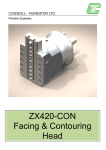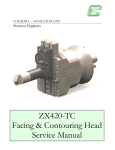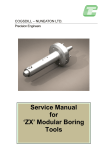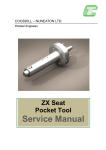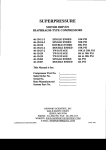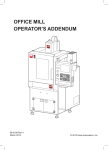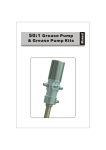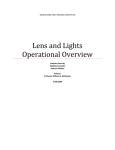Download ZX200-TC Facing & Contouring Head Service Manual
Transcript
COGSDILL – NUNEATON LTD. Precision Engineers ZX200-TC Facing & Contouring Head Service Manual PRECISION ENGINEERS ZX200-TC Facing & Contouring Head Service Manual Cogsdill – Nuneaton Ltd Tenlons Road • Nuneaton • England Phone: 44 (0) 24 76383792 • Fax: 44 (0) 24 76344433 Email: [email protected] ZX200-TC FACING & CONTOURING HEAD SERVICE Table of Contents Customer Order Details …………………………….. 1 Introduction ……………………………………………. 2 C HAPTER 1 Installation of Head ………………………………… 4 Camloc Adjustment …………………………………. 7 C HAPTER 2 General Maintenance ………………………………. C HAPTER 8 3 Dismantling of Facing Head ……………………… 9 Assembly of Facing Head …………………………. 12 Adjustment of Facing Head ………………………. 16 C HAPTER 4 Recommended Spares ……………………………… 17 Repair and Overhaul Procedure …………………. 18 C HAPTER 5 Torque Settings ……………………………………….. C HAPTER 6 Trouble Shooting ………………………………………. C HAPTER 19 20 7 General Arrangement Drawings …………………. i 21 MANUAL ZX200-TC FACING & CONTOURING Customer Order Details Customer : When contacting Cogsdill-Nuneaton for information about your order, please have this sheet to hand. Quote No : Works Order No : Sales Order Processing No : Additional Notes and Related Tooling : 1 HEAD SERVICE MANUAL ZX200-TC FACING & CONTOURING HEAD SERVICE MANUAL Introduction C Facing heads are designed to work on machines with live spindles, such as horizontal boring machines with C.N.C. controls. The combination of the spindle feed (z-axis) and the work piece (w-axis) enables most profiles to be accurately machined. The independent spindle feed (z-axis) is utilised to actuate the feed out mechanism in the facing head. Different makes of horizontal boring machine or machining centre, will have different home positions for their inner spindle (Shank gauge line to the spindle nose face). Cogsdill – Nuneaton’s facing heads are individually set to suit each customer’s machines if our standard home position will not fit. ogsdill-Nuneaton’s Use the Cogsdill – Nuneaton facing and contouring heads to machine large castings or components that are awkward for holding or rotating for conventional machining. External turning, grooving, taper boring, radius forming, chamfering, recessing, threading can all be finished in one set-up without removing the work piece from the machine tool table. Cogsdill – Nuneaton’s development of quality tooling and pursuit for continuous improvement in our product lines, has now resulted in a proven rugged design for it’s facing heads. All moving parts are precision ground and heat-treated to ensure lasting accuracy with next to no backlash. Oilways are built into internal slide mechanisms and lubrication is through easily accessible grease nipples. Cross-slides and actuators may be coated with a friction reducer to reduce actuation pressures, resulting in improved machining capabilities and reduced wear to critical parts upon request. When you the customer feel it necessary to design and manufacture your own tooling, please feel free to consult us about your intention. We can provide any information to you that you might need. Our aim is to serve and satisfy you the customer, please take advantage of this offer. 2 ZX200-TC FACING & CONTOURING HEAD SERVICE MANUAL Suitable for Horizontal Boring Machines with Size 4, 5 & 6 Inch Spindles DETAILS DIM'N (INCHES) (mm ) LENGTH EXCLUDING TOOLING A 15.600 396 SLIDE LENGT H B 7.8 80 200 MACHINE SPINDLE TRAVEL C 3.0 00 76 TOOL AND SLIDE TRAVEL D 1.5 00 38 0 - 15 0 - 380 800 R.P.M . - 236 Lbs 107 Kg GENERAL CAPACITY MAXIM UM RECOM MENDED SPEED WEIGHT (WITH ZX420-53 ADAPT OR NOSE) 3 ZX200-TC FACING & CONTOURING HEAD SERVICE MANUAL Chapter 1 Installation of Head 1. Locate Bonnet onto spindle nose of machine, ensuring both bonnet and spindle location faces are free from swarf chips and other foreign matter. Secure in position with four socket head screws. FIGURE 1.01 Loading Bonnet to Machine Spindle Nose. 4 ZX200-TC FACING & CONTOURING HEAD SERVICE MANUAL 2. Before commencing to load, the Contouring and Facing head onto the machine spindle nose. Check that the camlocs in the bonnet are in their open position. The camlocs are spring loaded and will pop up above the bonnet diameter approximately 2,00mm (.079”) when they are in the open position. FIGURE 1.02 3. Wind out Inner spindle of machine so that it protrudes the bonnet face 4. Load Contouring and Facing head into the spindle of the machine and clamp in position via drawbar or pullstud. FIGURE 1.03 Load head to spindle and clamp in place via pullstud or drawbar. 5 ZX200-TC FACING & CONTOURING HEAD SERVICE MANUAL 5. Slowly wind back the spindle, locating facing head into bonnet, until location faces are just clear or touching each other. 6. Clamp facing head in position by pushing down on the camlocs and turning them into the lock position. 7. Set inner spindle of machine to its home position. 8. The head is now ready for use. FIGURE 1.04 Wind back machine spindle, and secure head in position by turning Camlocs to lock position. 6 ZX200-TC FACING & CONTOURING HEAD SERVICE MANUAL Camloc Adjustment In the locked position, the indicator mark on the Camloc should be in between the two lines indicated by the arrow and lock marked on the Bonnet. FIGURE 1.05 Camloc Pin in locked position. If the Camloc does not lock, i.e. the indicator mark does not fall within the lock position, then the Camloc stud needs to be adjusted. To adjust, remove the caphead screw that retains the Camloc Stud and screw in or out to suit, replace the caphead screw after adjustment. FIGURE 1.06 Camloc Stud can be adjusted to ensure Camloc locks up. 7 ZX200-TC FACING & CONTOURING HEAD SERVICE MANUAL Chapter 2 Maintenance Operational reliabilty and trouble free service of high performance machinery and tooling depends on the correct selection and use of high quality specialised lubricants 1. It is recommend that a water resistant paste (Klüber-Altemp Q NB 50) be used in this type of tool. The paste should be applied to all moving parts or surfaces when the tool is dismantled for cleaning and maintenance or when the tool is stored for an extended period of time. 2. To lubricate the ZX200-TC head during use, it is recommended that a low soap grease (Calcuim Cup No.2) should be applied via the greae nipples, as a general guideline, every 200-300 operating hours or as deemed necessary in practice. The lubrication frequency can vary depending upon the working environment, working speed, coolant used, machine used, number of head actuations and distance stroked by the tool. 3. A lube gun (Ref. part No CN-D24) is available from Cogsdill-Nuneaton to make routine maintainance easy FIGURE 2.02 Lubrication Points on Main Body. FIGURE 2.01 Lubrication Points on Main Body & Cross-slide 8 ZX200-TC FACING & CONTOURING HEAD SERVICE MANUAL Chapter Dismantling of Facing Head. 3 Remove facing head from machine spindle (reverse instructions of Chapter 1) and remove any tooling fitted to cross-slide. Ensure prior to dis-mantling that items are suitably marked to ensure accurate re-assembly. Due to the close manufacturing tolerances, problems may occur if this method is not adhered to. Step 1. Remove adaptor nose (detail-17) from main body (detail-6) by removing four caphead screws (detail-106) and pulling off back of body. 2. Remove locking ball (details-112, 115, 117, 118). 3. Unscrew two taper lock screws (detail-8), and remove shank (detail-9). 9 ZX200-TC FACING & CONTOURING HEAD SERVICE MANUAL 4. Unscrew eight caphead screws (detail-107) and remove two keeper plates (detail-1). 5. Pull away cross-slide (detail-2) and attached slideblocks (details-3 & 4) from body (detail6), the actuator bar (detail-7) can now be removed by pulling out the back of the head, with attached coolant pipe (detail-13). 1 2 3 10 ZX200-TC FACING & CONTOURING HEAD SERVICE MANUAL 6. To remove slideblocks (details-3 & 4) from cross-slide (detail-2), unscrew four caphead screws (detail-5) from slideblocks. In removing slideblocks, identify their position with the cross-slide. If necessary, clamp the slideblock in a soft jawed vice and very gently tap the cross-slide free from the slideblocks. 7. The keys (details-10 & 11) can now be removed by unscrewing the two-countersunk head screws (detail 111). 8. The Coolant pipe (detail-13) can now be removed from the actuator (detail-7) if required, by removing two caphead screws (detail-110). Care must be taken not to mis-place the oring (detail-104) located underneath the coolant pipe. Inspect o-ring (detail-104) and quad ring (detail-101 & 102) for damage. Replace if necessary. 11 ZX200-TC FACING & CONTOURING HEAD SERVICE MANUAL Assembly of Facing Head. Ensure all parts are thoroughly cleaned and well lubricated before assembly. Make sure all parts are correctly assembled to each other. Use assembly drawing found in chapter 7 when following these assembly steps. Step 1. Make sure all slideblocks are fitted with spring plungers (detail-123), which on assembly close slideblocks (details-3 & 4) around actuator (detail-7) to produce a precision fit. 2. Fit cross-slide (detail-2) and slideblocks (details- 3 & 4) together. Locate slideblocks in position on the cross-slide with slipper slot facing towards the centre of the cross-slide and fix slideblocks in position with two special caphead screws (detail-5) per slideblock. Do not fully tighten yet. 3. Locate keys (details- 10 & 11) in position on actuator bar (detail-7) and secure by two countersunk head screws (detail-111). 4. Inspect o-ring (detail-104) and quad ring (detail-101 & 102) for damage. Replace if necessary. If coolant pipe (detail-13) has been removed from actuator (detail-7) re-fit now with o-ring (detail-104) fitted underneath coolant pipe. Secure coolant pipe in place with two caphead screws (detail-110), but leave caphead screws loose at this stage. 12 ZX200-TC FACING & CONTOURING HEAD SERVICE MANUAL 5. Position actuator bar (detail-7) into rear of main body (detail-6) with spade end towards the front of the head and vertical with cross-slide cavity and coolant pipe located in hole in main body. (It is helpful to hold the body in a soft jawed vice, to ensure the location diameter is protected). Offer the cross-slide assembly with attached slideblocks onto the actuator and slide the unit down the actuator keys until the spring plungers (detail-123) rest on the keeper plate location face. Using the keeper plates (detail-1), depress the spring plungers simultaneously and push down to the home position. Damage to the spring plungers will occur if this procedure is not followed. 1 2 3 6. Replace keeper plates (detail-1) and tighten up eight caphead screws (detail-107) through keeper plates. 7. Check actuator (detail-7) moves freely forward & backwards then fully tighten two caphead screws (detail-110) securing coolant pipe (detail-13) to the actuator (detail-7). 13 ZX200-TC FACING & CONTOURING HEAD SERVICE MANUAL 8. The spring plungers will push the slideblocks onto the actuator blade and therefore the slideblocks can now be fully tightened by means of four access holes in the top face of the cross-slide (detail-2). Using an Allen key turn the four special caphead screws (detail-5) anticlockwise to tighten. The following procedure should be adhered to. Lightly nip the four special screws (detail-5) in an anti-clockwise direction, moving the actuator in and out of the head to actuate the slide. Continue to tighten the four special screws and moving the actuator until the screws are fully tightened. Do not over tighten special screws, as damage to the head will result. 9. Replace shank (detail-9) and secure in position with two taper lock screws (detail-8). Now move shank to home position. 14 ZX200-TC FACING & CONTOURING HEAD SERVICE MANUAL 10. Re-fit locking ball (details-112, 115, 117, 118) to hole in main body (detail-6). The ball (detail-118) will seat in a groove in actuator diameter (detail-7) when the shank is set to home position. 11. Refit adaptor nose (detail-17) to main body (detail-6) and secure in position with four caphead screws (detail-106). 12. Actuate head to home position and check head moves freely across full range of stroke. 15 ZX200-TC FACING & CONTOURING HEAD SERVICE MANUAL Adjustment of Facing Head If adjustment through wear is needed on the slideblocks the following procedure should be followed. Step 1. Dismantle the Contouring and Facing head as described previously. – Do not remove slideblocks. 2. Replace worn keys in actuator if necessary. 3. Remove one slideblock from cross-slide and check both slideblocks for any wear, replace if necessary. 4. Assemble facing head to procedure previously stated and check actuator can move freely, without play, between slideblocks. The spring plungers should ensure this. 5. Check actuator and cross-slide move freely in body. 6. If actuator, slideblocks or tenon keys are worn, and spares are ordered individually (not in a set), it may be necessary to grind the datum faced marked, once the sides of the slideblocks are set in position (See figure 3.01). It is recommended that units are returned for service if repair facilities are not available, matched actuators and slideblocks can be supplied to save down time. 16 ZX200-TC FACING & CONTOURING HEAD SERVICE MANUAL Chapter 4 Recommended Spares 1. Slideblock Detail 3. 2. Slideblock Detail 4. 3. Actuator Detail 7. 4. Key Detail 10. 5. Key Detail 11. 6. O-ring set for head. 17 ZX200-TC FACING & CONTOURING HEAD SERVICE MANUAL Repair and Overhaul Procedure Cogsdill can offer the following set maintenance and overhaul service to ensure guaranteed and trouble free operation. Fit this service into your preventative maintenance schedule. Stage 1. Over-size keys up to .005 Inches • Slideblocks re-ground. • Grease all over. • Plus any minor adjustments to slideblocks and keeper plates. • All o-rings, screws and plungers to be replaced. 2. Over-size keys up to .010 Inches • Slideblocks re-ground. • Hard Chrome and re-grind actuator bore. • Re-grind actuator shaft. • Grease all over. • Plus any minor adjustments to slideblocks and keeper plates. • All o-rings, screws and plungers to be replaced. 3. Over-size keys up to .015 Inches • Replace slideblocks. • Replace Keys. • Grind actuator bore back to original size. • Re-grind actuator shaft. • Re-fit new actuator. • Grease all over. • Plus any minor adjustments to slideblocks and keeper plates. • All o-rings, screws and plungers to be replaced. Note! In the event of the Contouring and Facing Head being damaged, we strongly advise customers to return the heads to Cogsdill – Nuneaton Ltd for repair. 18 ZX200-TC FACING & CONTOURING HEAD SERVICE MANUAL Chapter 5 Torque Settings All values are based upon plain black finish screws. DETAIL No. -107 -5 -111 -23 THREAD SIZE M8 M10 M4 M8 TORQUE (Nm) 26 26 4 Hand Tight The above table is intended for general guidance only. In practice, the actual torque tightening value’s can vary on whether the screws are lubricated or not. Common sense should prevail in the application of the above values. Another method of determining the clamping pressure is to tighten (with an Allen key/hexagon wrench) to finger tight and then a further 30 degrees past this position. Cogsdill – Nuneaton will not take any responsibility for miss-use of this information, which leads to damage, or injury of head, tooling, or personal 19 ZX200-TC FACING & CONTOURING HEAD SERVICE MANUAL Chapter 6 Trouble Shooting Inevitably, problems occur with any tool. Some of these are due to lack of experience with this type of tooling and others due to wear. Some of these problems can be quickly overcome in your factory and others will necessitate returning the tool to Cogsdill – Nuneaton Ltd for overhaul and repair. To help you to determine which course of action is required, we have listed a few of these points and subsequent checks to help you. If you require further assistance please ask us for help. 1. Difficulty in moving actuator when assembled to machine spindle or excessive pressure required moving actuator. • • • • • • • Check that the actuator moves free off the machine. Check concentricity of drawbar. Check drawbar has not been over-tightened and has caused damaged to the actuator blade. Check that the head has been assembled correctly. Check that the retaining screws are not over tight and have not distorted the body. Check if using a bonnet face, that it is flat, parallel, and free from any surface imperfections. Check all greaseways are clear and not blocked. 2. Inconsistency in component sizing. • • • • • Check for radial pay in actuator, re-adjust slideblocks against actuator blade. Check for wear on keys and key slots in slideblocks – replace as required. Insufficient lubrication being used, try lubricating regularly. Check for out of balance situation when head is stroked. Check clearance between cross-slide and keeper plates. On no condition force the actuator for extra movement, but contact Cogsdill – Nuneaton Ltd for advice. 20 ZX200-TC FACING & CONTOURING HEAD SERVICE MANUAL Chapter General Arrangement Drawings. 7 • General Arrangement drawing of ZX200-TC. • Standard tooling available for ZX200-TC. 21
























